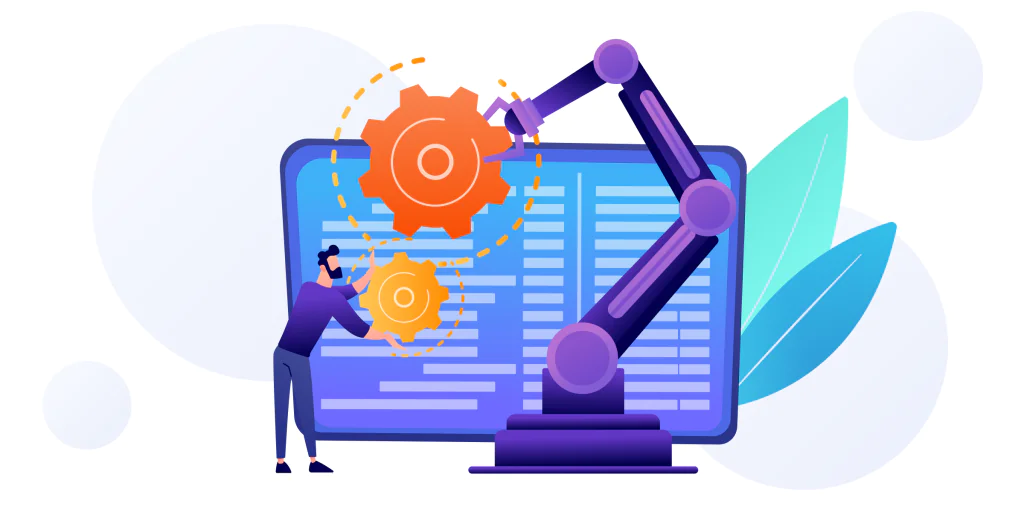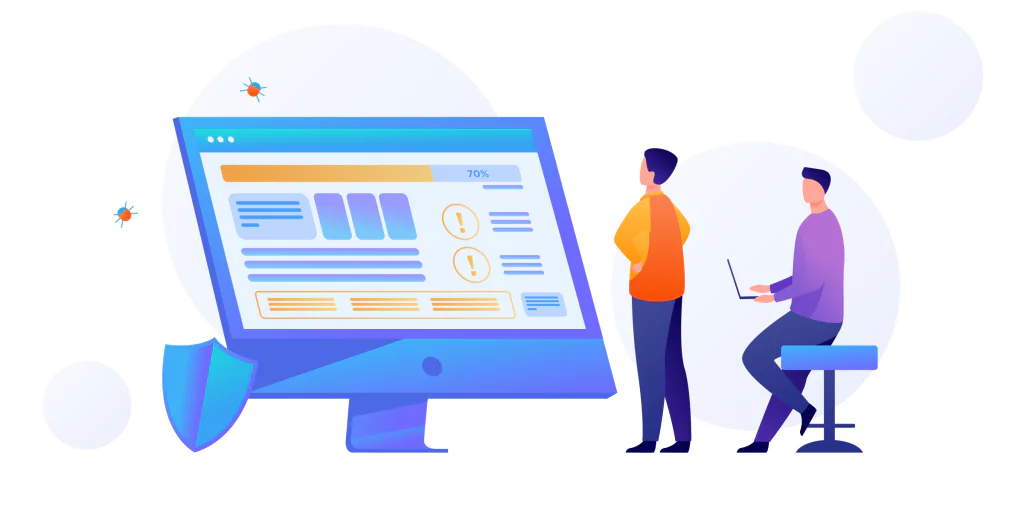Table of contents
We live in the no-code/low-code technologies era. But to understand how big an impact this truly makes on the development of humankind, it’s crucial to see where it all started. In this article, we’ll share some history of coding evolution and its impact on the technological capabilities of our civilization.
First No-Code/Low-Code Technologies
No-code and low-code technologies are visual-based programming approaches that make coding available to a broader range of specialists. In essence, using this technology, you don’t have to be a skilled developer yourself. You can use the visual interface to build solutions, much like LEGO blocks. This approach is getting extremely popular now. It’s because global digitalization boosts the demand for customized apps that can be used for anything from sorting one’s emails to managing a smart home.
The term low-code was introduced only in 2016. But the technology had been in development for decades prior. In fact, the first technologies that evolved into the low-code of today appeared back in the 1970-1990s as a part of 4the Generation Programming Language and Rapid Application Development.
It might surprise many, but the first no-code platform was Microsoft Excel, released in 1985. It was working with spreadsheets that became the origin of technology that’s revolutionizing our world today.
The development of this tech was pushed forward by cloud computing in 1997 and Salesforce in 2000. Salesforce proclaimed the rise of SaaS and boldly stated that it’s now the end of history for traditional software development.
From then on, it was:
- 2006 Formstack.
The first no-code form builder by Ade Olonoh. - 2006 Shopify.
The launch of a no-code eCommerce platform that is currently valued at around $37 billion. - 2007 iPhone.
The launch of the first iPhone triggered the rise of mobile app builders. - 2012 Bubble.
Launch of the first no-code web development platform. - 2013 Webflow.
The first platform that allows for 100% no-code creation of websites and apps. - 2018 Microsoft Power Platform.
PowerBI, Flow, and PowerApps become a part of the platform that grants better connectivity with minimum coding requirements.

CASE (Computer-Aided Software Engineering)
Let’s take a look at how the no-code/low-code approaches evolved. The very first technology using these methodologies was CASE, Computer-Aided Software Engineering. As the name states, this technology implies using computers to facilitate software development. It’s applied to increase quality and reduce the number of bugs.
CASE is a checkpointed approach that helps everyone involved in the project to observe its development milestones. Moreover, it’s used for storing project-related documentation. CASE is an excellent labor-saver, and it helps keep the project organized and increases team productivity.
As of today, this approach is considered outdated because there are more efficient technologies available. However, CASE made a valuable contribution to software development evolution.
CMS (Content Management System)
No-code/low-code approaches are widely used in CMS today. However, due to the versatility of content management systems, applications of these approaches and full code can be used in different combinations. We’ll list some of the best examples.
- WordPress.
WP is a monolithic CMS that allows for low-code or completely no-code use from the front-end side of website development. You can literally set up a website using nothing but templates and have zero coding knowledge. Meanwhile, you can take it further by adjusting the PHP and CSS files. Therefore, you can apply the low-code approach. - Joomla.
Joomla comes in second in popularity after WordPress, though it’s dwindling these days. It also offers lots of flexibility for no-code/low-code work. The framework is very user-friendly, so many businesses choose it to enable specialists to do immediate content work. - Shopify.
Visual site builders relying on no-code/low-code technology became extremely popular with the rise of eCommerce. Shopify and similar eCommerce platforms allow launching a store within a day max. Shopify is very flexible regarding the low-code approach as it enables devs to customize the store. Therefore, it effectively resolves the issue of the limited visual branding, which is a problem for no-code platforms that only accept a small number of presets. - Wix.
Wix isn’t exactly a CMS but a visual website builder. It’s one of the trendiest tools of this kind today, which isn’t a surprise. Using Wix requires no coding knowledge whatsoever. You can create websites extremely fast using a wide range of templates for any feature you need.
CRM (Customer Relationship Management)
Application of no-code/low-code approaches allowed to take customer service as a whole to a new level. Customer relationship management systems handle aggregating, processing, and monitoring leads and customers. One can also use them for generating a variety of reports that can have a huge impact on business development.
No-code and low-code technologies make it possible for businesses to handle these tasks with minimal developer involvement. On the other hand, developers can focus on more important tasks and automate customer management for more efficient operation. When used well, these systems can collect and process vast amounts of data from all website interactions and produce valuable insights.
RAD (Rapid Application Development)
You could say that low-code, as we know it today, is a subset of RAD. Rapid Application Development platforms date back to 1991, and some of them evolved into the low-code platforms of today.
All in all, RAD is a part of the technology’s past. Meanwhile, low-code is what’s trending at present. However, RAD is still used occasionally. In particular, RAD is applied in projects that require integrating complex and highly specific business approaches with the UX-first approach.
For example, solutions that would benefit from the RAD approach include features like:
- SaaS cloud monetization;
- Multi-tenancy;
- Developing a single code for cloud, mobile, on-premise, and web apps;
- Establishing complex business rules;
- No vendor lock-in.
ERP (Enterprise Resource Planning)
In a way, ERP is a more evolved and enterprise-oriented type of CRM. However, instead of managing customer data and information about their interactions with the business, ERP manages business processes and resources. The purpose of ERP solutions is to plan the most efficient use of resources to improve the overall efficiency and economy of the client-enterprise.
In the best-case scenario, a business should use both CRM and ERP software to enable the highest productivity and efficiency. In this context, no-code/low-code approaches allow the creation of solutions that one can adapt to unique business needs. Therefore, they help achieve the best possible results.
ERP development is where low-code technologies are developing most rapidly today due to high demand. As global markets enter a crisis and competition becomes fiercer, businesses have no choice but to seek maximum process optimization. No-code/low-code technologies provide them with solutions that can constantly achieve that result and improve.

Differences Between No-Code, Low-Code, and Pro-Code
To put it plainly, the difference between no-code, low-code, and pro-code approaches is the level of professional developer knowledge one needs to have to build applications.
With no-code, anyone can create an app even without any specialized knowledge. Low-code approach is more varied and requires some knowledge. It’s best suited for IT professionals or power users who need assistance from the machine to speed up, simplify, and automate processes. Pro-code, as the name suggests, is restricted to professional developers who can write the entirety of code from scratch.
From the app creation point of view, it looks like this:
- No-code.
Anyone can use the platform app builder to create a basic app using the ‘blocks’ afforded by the solution. No coding is necessary as the process is more like working with LEGO. Most no-code platforms have a simple drag-and-drop menu and can cater to a wide range of businesses. - Low-code.
Low-code technologies allow customizing existing apps using scripts. You must have a decent understanding of coding. However, it’s rather low-level, so even non-professionals with some coding knowledge can do it. You can also study plenty of helpful guides and other materials online. - Pro-code.
There are but a few things pro-coders cannot do. Regarding apps, they usually work on expanding their functionality through plugins. However, being total pro developers, depending on specialization, they can build an app from scratch.
It’s important to note that low-code and pro-code development aren’t mutually exclusive. It means that pros can use the low-code approach in some of their projects. In fact, this can help boost their overall efficiency and productivity.

No-Code/Low-Code Applications Today
Applications of no-code/low-code approaches are extremely versatile today. This technology helps strengthen enterprises, enhance smaller businesses, and open new opportunities for everyone.
Here are some examples:
- Web-based portals for customers.
Web-based portals are perfectly suited for customers as they enable them to handle many routine tasks. For example, searching for services, getting quotes, making payments, etc. Low-code allows businesses to launch such portals fast. Therefore, they can enhance customer experience and keep improving it continuously. - B2C mobile apps.
Another way to enhance customer experience and satisfaction is by launching mobile apps. Again, low-code technology here allows to speed up the creation of such apps. Moreover, these mobile apps must be highly customizable. Therefore, a business can build a perfect match for its customers. - Core systems.
No-code/low-code technologies offer an alternative to the traditional approaches of either buying a commercial core system or rebuilding the legacy one. The low-code alternative is more cost-efficient and flexible. It uses collaborative agile methodology applied to the application lifecycle. Cloud-native apps built on low-code portals are easily portable and can scale and ensure maximum uptime. - Monoliths to microservices transformation.
Monolithic and microservices architectures both have pros and cons. However, microservices clearly are more popular now. Therefore, the number of enterprises switching to this type is increasing. Realistically, breaking down a monolith into microservices is hard and expensive. Low-code portals facilitate this task. Businesses can use them to launch microservices apps and functionalities. Essentially, today one can use APIs to ‘redevelop’ the architecture. - SaaS development.
Building SaaS products can be challenging and risky. But with low-code platforms, the process becomes cheaper and faster. So, you can create, test, and roll out an app fast and see how it performs to plan future business strategies. - IoT-enabled apps.
IoT solutions increase operational efficiency, but they are complex. No-code/low-code approaches allow easy integration with existing IoT platforms and the development of cost-efficient smart apps.

Presented by Viktor Kalinichenko, Devtorium No-Code/Low-Code Expert
According to Forrester surveys, about 75% of development shops are already adopting no-code/low-code technology or plan to do so. Considering the benefits and cost-savings it offers, this trend will only grow. We are already witnessing an unprecedented rise in low-code use, primarily among developers.
Here at Devtorium, we have it on good authority that no-code/low-code is the future that’s already happening. Our expert on this technology is Viktor Kalinichenko, who has worked in the IT industry since 1999. For over two decades now, Viktor has been watching technological approaches come and go. He used all the options listed above himself. Now he firmly believes that low-code is here to stay for a while. According to his expert opinion, it’s because the technology allows delivering top-grade results fast. Therefore, clients seeking to succeed in competitive markets are creating great demand. And compared to previous computer-assisted development technologies, no-code/low-code portals of today truly get the job done.
To those who wish to study this technology, Viktor recommends starting with something simple and popular, for example, Bubble or WebFlow, which you could learn using Bubble Academy or WebFlow university courses. The community there is also an excellent pointer to valuable materials on the subject. In addition, he says that all you need to jump into the no-code/low-code is to know how to use a mouse and have some business analytics skills. He promises to explain this in more detail in our upcoming articles that will focus on our own no-code/low-code developments and detailed studies of existing solutions.
See you soon in our future posts😉!




